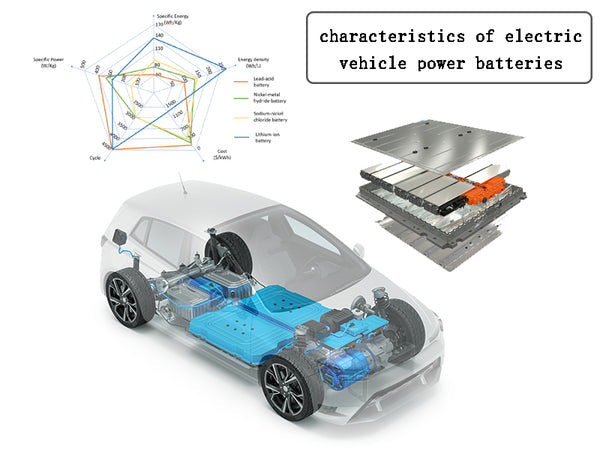
|
Main content: |
1.Lead-acid battery

Lead-acid batteries are the most widely used batteries for electric vehicles in the initial development stage. Its advantages mainly include low cost, easy acquisition of battery raw materials, simple manufacturing process, etc., and its specific power can basically meet the power performance requirements of electric vehicles. The application characteristics of lead-acid batteries in electric vehicles are shown in Table 1.
| Types of lead acid batteries | Main feature | Types of Electric Vehicles Applied |
| Open tube lead-acid battery | High specific energy, good cycle life, automatic water addition, less maintenance | Light, medium and large passenger cars, service and sanitation vehicles |
| Valve Regulated Gel Tubular Lead-Acid Battery | High specific energy, specific mass and specific power, as well as good cycle life, maintenance-free | Light, medium and large passenger cars, service and sanitation vehicles, vans |
| Flat VRLA battery | High specific power, maintenance free | Light, medium and large passenger cars, service and sanitation vehicles, trucks |
| Thin Flat VRLA Battery | High peak power, shallow cycle discharge, maintenance free | Hybrid Electric Vehicles for Various Purposes |
Table 1 Application characteristics of lead-acid batteries in electric vehicles
2.Nickel-cadmium batteries

Nickel-cadmium battery is an alkaline battery, which is one of the battery types that can be selected for pure electric vehicles (EV), fuel cell electric vehicles (FCEV) and hybrid electric vehicles (HEV). It is used as a backup power supply on locomotives and vehicles. The specific energy of the nickel-cadmium battery can reach 55Wh/kg, and the specific power exceeds 225W/kg. The plate has high strength, stable working voltage, and can be charged with electricity and can be charged quickly. Nickel-cadmium batteries have good overcharge and overdischarge performance, high rate discharge characteristics, large instantaneous pulse discharge rate, and good deep discharge performance. Long cycle life, fully enclosed shell, can work normally in vacuum environment. The low temperature performance is good, it can work normally in a temperature environment of 4080℃, and can be stored for a long time. The working voltage of nickel-cadmium battery is lower. The nominal voltage of the single battery is 1.2V. The DOD during deep discharge can reach 100%, the self-discharge rate is lower than 0.5%/d, and there is also a memory effect. In addition, cadmium (Cd) used in nickel-cadmium batteries is a harmful heavy metal that must be efficiently recycled after the batteries are scrapped.
3.Ni-MH batteries

Nickel-metal hydride batteries are one of the more successful nickel-based batteries and have been used in mass-produced hybrid vehicles. The positive electrode of the NiMH battery is nickel hydroxide and the negative electrode is metal hydride. Under certain temperature and pressure conditions, metal alloys can absorb a large number of hydrogen molecules to form metal hydrides. The alloy composition in NiMH batteries is AB (mainly including AB, A2B, AB, AB, AB, A2B). In the AB alloy, A is a mixture of rare earth elements, and B is nickel or some metal that can replace nickel. In AB alloys, A is titanium or zirconium, or a combination of the two, and B is nickel or another alternative metal. Ni-MH battery has stable discharge characteristics, its specific energy is 60~80Wh/kg, and the single-cell voltage of Ni-MH battery is 1.2V. Long mileage, no pollution to the surrounding environment, easy maintenance, quick recharge, short charging time, etc.
However, NiMH batteries also have some shortcomings, mainly reflected in the fact that NiMH batteries are prone to heat during charging, and the high temperature generated by the heat will have a negative impact on the battery. This is because a high temperature state deteriorates the charging efficiency of the positive plate and accelerates the oxidation of the positive plate, resulting in a shortened battery life. In addition, NiMH batteries will generate a large amount of oxygen in the later stage of charging. Under high temperature environmental conditions, the oxidation of the negative electrode hydrogen storage alloy will be accelerated, and the equilibrium pressure of the hydrogen storage alloy will increase, resulting in a decrease in the hydrogen storage capacity of the hydrogen storage alloy. Performance of NiMH batteries. To this end, the following improvements can be made in the manufacturing technology of nickel-hydrogen batteries, such as by using multi-pole ear technology on the positive plate, using end-face welding technology on the negative plate, adding LOH and NaOH to the electrolyte appropriately, using anti-oxidation technology The high-performance polypropylene felt as a separator can effectively improve the high temperature resistance of nickel-metal hydride batteries. In addition, it is also possible to increase the heat dissipation gap between the single cells of the NiMH battery pack, and take effective heat dissipation measures and establish an automatic thermal management system, so as to ensure the normal operation of the NiMH battery and prolong its service life.
















